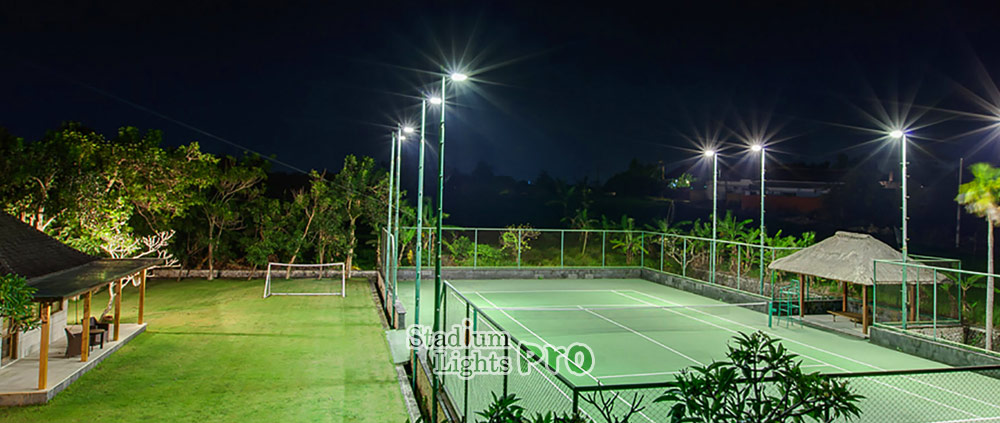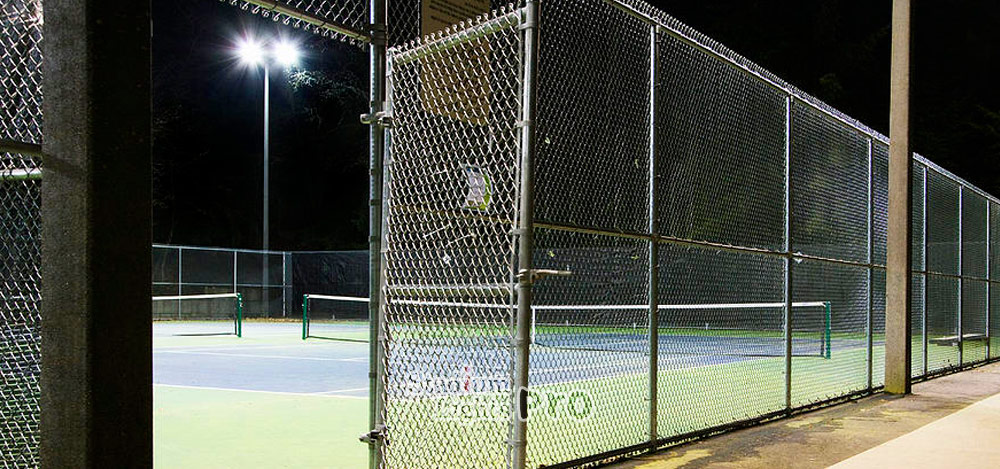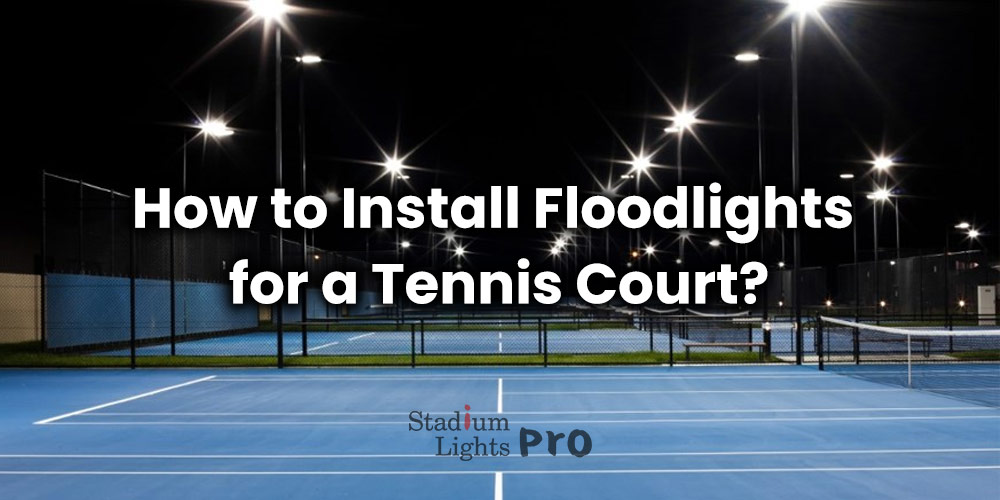Table of Contents
ToggleDetermine the location of the tennis court floodlights
When installing floodlights for a tennis court, we need to determine the location of the floodlights carefully. The floodlights should be installed on poles around the perimeter of the court, with the poles placed at least 20 feet (6 meters) from the edge of the court. This will ensure that the floodlights are positioned in a way that provides sufficient illumination for the entire court without causing shadows or glare. It is also critical to evenly space the floodlights around the court to ensure that the illumination is consistent throughout the playing area.
Determine the height of the floodlights

The tennis court floodlights should be mounted at a height of at least 25 feet (7.5 meters) above the ground to allow the light to cover the entire court and minimize shadows. If the floodlights are mounted at a lower height, they may not provide sufficient illumination for the entire court and may create shadows that can affect play. By mounting the floodlights at a height of 25 feet or higher, you can ensure that the floodlights provide uniform illumination for the entire court and minimize shadows.
Determine the power of the floodlights
The floodlights should be powerful enough to provide sufficient illumination for the entire tennis court. The minimum recommended illuminance for a tennis court is 500 lux, but it is generally recommended to use floodlights with an illuminance of 1000-2000 lux for best results.
To determine the power of the floodlights you need, you should consider the size of the court, the height of the poles, and the ambient light conditions at the location of the court. For example, if the court is located in an area with low ambient light levels or if the poles are mounted at a height of 25 feet or higher, you may need to use floodlights with a higher illuminance to provide sufficient illumination.
It is also essential to consider the color temperature of the floodlights. For tennis courts, it is generally recommended to use floodlights with a color temperature of 4000-5000K, as this provides a bright, white light that is easy on the eyes and helps players see the ball clearly.
Install the floodlights
Install the poles
The first step in installing the floodlights is to install the tennis court poles. This typically involves digging holes for the poles and setting them in concrete. The poles should be placed at least 20 feet (6 meters) from the edge of the court and should be evenly spaced around the court.
Mount the floodlights
Once the poles are in place, you can mount the floodlights on the poles. This typically involves attaching brackets to the poles and securing the floodlights to the brackets using bolts or screws.
Run electrical cables
After the floodlights are mounted on the poles, you will need to run electrical cables from the floodlights to a power source. This typically involves burying the cables underground or running them along the surface of the tennis ground.
Connect to a power source
Once the electrical cables are in place, you can connect the floodlights to a power source. This may involve installing a new electrical panel or outlet, or connecting to an existing power source.
Test the tennis court floodlights
Once the floodlights are installed, we need to test them to ensure that they are providing sufficient illumination and that there are no shadows on the tennis court. Here are some steps you can follow to test the floodlights for a tennis court:
Turn on the floodlights
The first step in testing the tennis court floodlights is to turn them on. This will allow you to see the intensity and distribution of the light.
Walk around the court

As you walk around the tennis court, pay attention to the intensity and distribution of the light. The floodlights should provide uniform illumination across the entire court, with no areas of excessive brightness or shadow.
Check for shadows
Look for shadows on the court, especially near the net and in the corners. Shadows can affect play, so it is suggested to minimize them as much as possible.
Adjust the floodlights as needed
If you notice any areas of excessive brightness or shadow, you may need to adjust the position or angle of the floodlights to achieve the best lighting. This may involve adjusting the brackets or mounting brackets on the poles or adjusting the angle of the floodlights.
Test the floodlights at night
It is also a good idea to test the floodlights at night to see how they perform in low light conditions. This will allow you to see if the floodlights provide sufficient illumination for play and if there are any shadows on the court.
Maintain the floodlights
We may maintain the floodlights on a regular basis to ensure that they are functioning properly. Here are some steps you can take to maintain the floodlights for a tennis court:
Clean the floodlights
Dust and debris can accumulate on the floodlights over time, which can affect the intensity and distribution of the light. To keep the floodlights working efficiently, it is a good idea to clean them regularly. You can use a soft cloth or brush to gently clean the exterior of the floodlights.
Check the bulbs
The bulbs in the floodlights will eventually burn out and need to be replaced. To ensure that the floodlights are providing sufficient illumination, it is necessary to regularly check the bulbs and replace any that have burned out.
Check the electrical connections
It is also a good idea to check the electrical connections on the floodlights regularly to ensure that they are secure. Loose connections can cause the floodlights to malfunction or even pose a safety hazard.
Inspect the poles and mounting brackets
The poles and mounting brackets that hold the floodlights should be inspected regularly to ensure that they are in good condition. If any parts of the poles or mounting brackets are damaged, they should be repaired or replaced to ensure that the floodlights are securely mounted.
Conclusion
Installing floodlights for a tennis court involves determining the location, height, and power of the floodlights, installing the floodlights, testing them, and maintaining them. By following these steps and paying careful attention to the placement, height, and power of the floodlights, you can ensure that the floodlights provide the best possible illumination for the court and do not affect play. Regular maintenance of the floodlights, including cleaning, checking the bulbs, and inspecting the poles and mounting brackets, will help to ensure that the floodlights continue to function properly and provide sufficient illumination for the court.
If you are interested in installing floodlights for a tennis court, we encourage you to contact us to get a free lighting design and price quote. Our team of experts will work with you to design a lighting system that meets your specific needs and budget. We can provide a detailed quote that includes the cost of the floodlights, installation, and any necessary electrical work.
With our experience and expertise, we can help you choose the best floodlights for your tennis court and ensure that they are installed correctly. We take pride in our work and strive to provide the best possible service to our customers.
To get started, simply contact us and provide us with some basic information about your tennis court and lighting needs. We will get back to you with a free lighting design and price quote. We look forward to helping you create the perfect lighting system for your tennis court.

